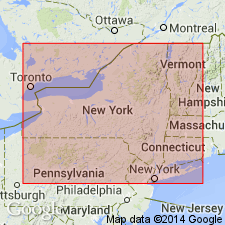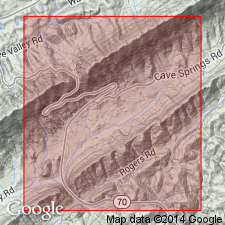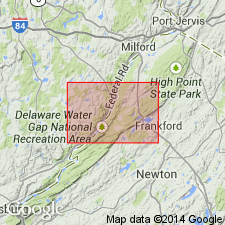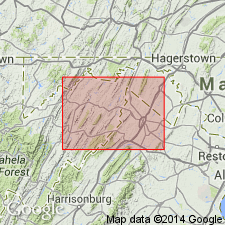
- Usage in publication:
-
- Oriskany sandstone
- Modifications:
-
- Original reference
- Dominant lithology:
-
- Sandstone
- AAPG geologic province:
-
- Appalachian basin
Summary:
Pg. 273. Oriskany sandstone. White sandstone occurring on the hill at the falls of Oriskany, which for present may be called Oriskany sandstone. Is well known to extend over several States. Is 30 feet thick at Oriskany Falls; at quarries near Auburn it is a few inches to 2.5 feet thick; is 700 feet thick in Pennsylvania. Rests on water-lime group of Manlius and is overlain by 8 to 12 feet of gray sparry crinoidal limestone. Age is Early Devonian.
Source: US geologic names lexicon (USGS Bull. 896, p. 1561-1562).

- Usage in publication:
-
- Oriskany group*
- Oriskany sandstone*
- Oriskanian*
- Modifications:
-
- Overview
- AAPG geologic province:
-
- Appalachian basin
Summary:
For many years the name Oriskany sandstone was commonly applied to the rocks below Esopus grit. The 1863, 1864, 1868, 1869, 1875, and 1895 editions of Dana's Textbook of Geology used the time term Oriskany period to cover the Oriskany sandstone only, excluding Esopus grit and pre-Oriskany sandstone rocks. In 1898, F.J.H. Merrill (New York State Mus. Bull., v. 4, no. 19, p. 158) employed the term Oriskany group to include †Cauda Galli grit [Esopus grit] and underlying Oriskany sandstone, stating that only fossil of the grit is SPIROPHYTON CAUDA GALLI, which also occurs in Oriskany sandstone. A.W. Grabau (1898, Buffalo Soc. Nat. Hist., v. 6, p. xviii), included Schoharie grit and Esopus shale in what he called Schoharie stage, and used Oriskany stage to cover Oriskany sandstone only. In 1899 J.M. Clarke and C. Schuchert (Science, n.s., v. 10, p. 874-878) introduced Oriskanian period or group to cover the Oriskany beds, which they defined as underlying Esopus grit and overlying Kingston beds [Port Ewen limestone]. In 1900 Schuchert, also J.M. Clarke, employed Oriskanian in latter sense, but Schuchert divided the Oriskany into Upper Oriskany and Lower Oriskany. In 1901 (New York State Mus. Bull., no. 52) and 1902 E.O. Ulrich and C. Schuchert, also A.W. Grabau, applied Oriskanian to the pre-Esopus and post-Kingston beds, but also stated that the Esopus "is only a phase of the Oriskany." The same year F.J.H. Merrill (geol. map of New York) included the Esopus in the Oriskany, while A.W. Grabau excluded both Esopus and Kingston from the Oriskanian. In 1903, (Amer. Geol.) Schuchert included in Oriskanian the following (descending): Decewville, Esopus, Oriskany, and Kingston. The same year (New York State Mus. Bull., no. 69) G. Van Ingen and P.E. Clark, also J.M. Clarke, applied Oriskanian to Oriskany sandstone (pre-Esopus and post-Port Ewen). In 1906 Grabau included in Oriskanian group the Esopus grit and Oriskany sandstone. In 1908 G.H. Chadwick (Science) divided the Oriskanian of New York into Esopus, Glenerie limestone, Connelly conglomerate, and Port Ewen (†Kingston), with a statement that the Glenerie and Connelly are = the Oriskany, and that Oriskany fossils occur in the Esopus (Decewville), 40 feet above its base, "so that at least lower part [of that formation also] is Oriskany." In 1909 J.M. Clarke included the Port Ewen in the Oriskany. In 1911 (GSA Bull., v. 22), E.O. Ulrich divided the Oriskany into Esopus, Glenerie, Connelly, and Port Ewen, and assigned the Decewville to the overlying group. In 1912 (New York State Mus. Hdbk., no. 19) C.A. Hartnagel divided Oriskanian group of eastern New York into Esopus, Glenerie, Connelly, and Port Ewen, and also used Oriskany sandstone for the pre-Esopus and post-Becraft beds of east-central to western New York.
The USGS at present [ca. 1938] uses Oriskany group in a broad sense, to include the Esopus at the top and the Port Ewen at the base, and where the undifferentiated deposits of Oriskany age are chiefly or wholly sandstone, it applies to them the term Oriskany sandstone. In central Pennsylvania, western Maryland, northern West Virginia, and parts of Virginia, the Oriskany group is divided into Ridgeley sandstone (above) and Shriver chert (below). The present New York State Survey uses Oriskanian to include Esopus grit (above) and Oriskany sandstone (below), and has transferred Port Ewen limestone to underlying Helderberg group (see W. Goldring, New York State Mus. Hdbk., no. 10, 1931, p. 370).
Source: US geologic names lexicon (USGS Bull. 896, p. 1561-1562).

- Usage in publication:
-
- Oriskany Member
- Modifications:
-
- Areal extent
- Revised
- AAPG geologic province:
-
- Appalachian basin
Summary:
Oriskany extended to northeastern TN as Member of Wildcat Valley Sandstone. Measured section in cuts along TN Rte 70, between crest of Clinch Mountain at Little War Gap and gap through Pine Mountain, Hawkins Co. described. Here unit is 9.4 ft and consists of coarse, thickly bedded, conglomeratic quartzose sandstone. Weathers yellowish orange to yellowish brown. Overlies Clinch Sandstone; underlies Huntersville Member of Wildcat Valley Sandstone. Age is Early Devonian.
Source: GNU records (USGS DDS-6; Reston GNULEX).

- Usage in publication:
-
- Oriskany Group
- Modifications:
-
- Revised
- AAPG geologic province:
-
- Appalachian basin
Summary:
Oriskany mapped at Group rank in Sussex Co., northwestern NJ, where it is subdivided into Glenerie Formation (55 to 170 ft), Shriver Chert (0 to 28 ft), and Ridgely Sandstone (0 to 32 ft). Total thickness of group is approximately 170 ft. Age is Early Devonian.
Source: GNU records (USGS DDS-6; Reston GNULEX).

- Usage in publication:
-
- Oriskany Sandstone*
- Modifications:
-
- Biostratigraphic dating
- AAPG geologic province:
-
- Appalachian basin
Summary:
Conodont biostratigraphy indicates that the Oriskany Sandstone in the Winchester 30 X 60 minute quadrangle is of Early Devonian (Pragian) age. Conodonts from the underlying Shriver Chert and Licking Creek Limestone are indicative of a latest Lochkovian and earliest Pragian fauna.
Source: GNU records (USGS DDS-6; Reston GNULEX).
For more information, please contact Nancy Stamm, Geologic Names Committee Secretary.
Asterisk (*) indicates published by U.S. Geological Survey authors.
"No current usage" (†) implies that a name has been abandoned or has fallen into disuse. Former usage and, if known, replacement name given in parentheses ( ).
Slash (/) indicates name conflicts with nomenclatural guidelines (CSN, 1933; ACSN, 1961, 1970; NACSN, 1983, 2005, 2021). May be explained within brackets ([ ]).

